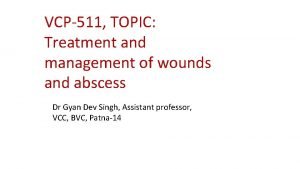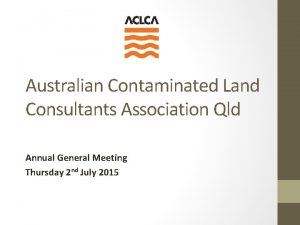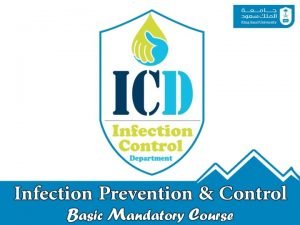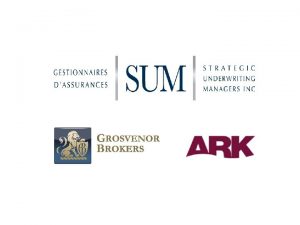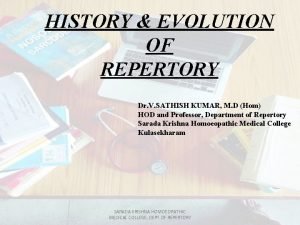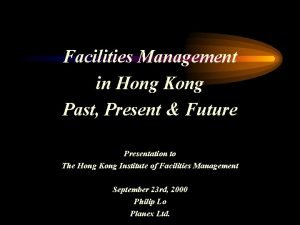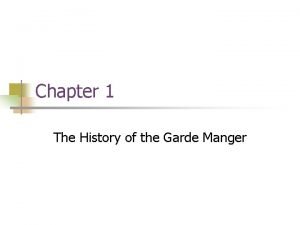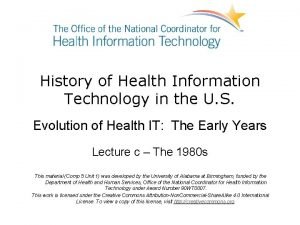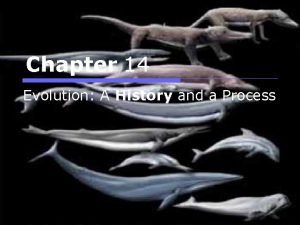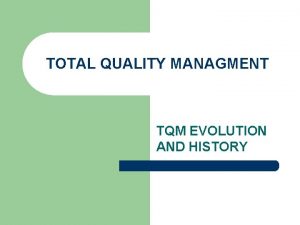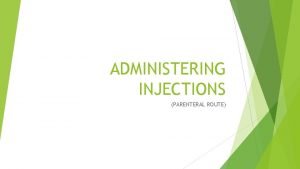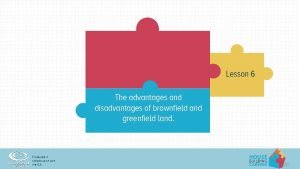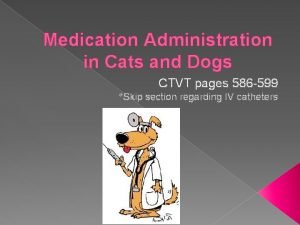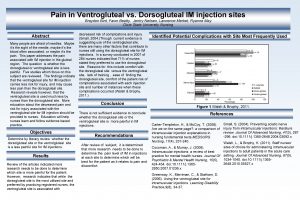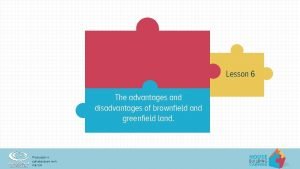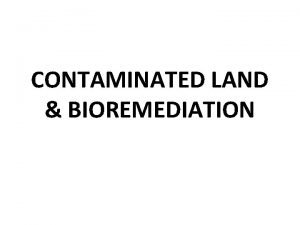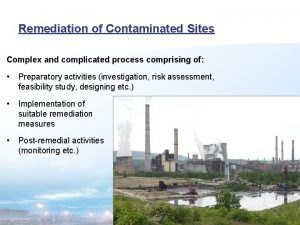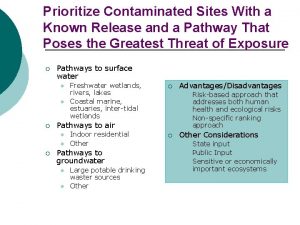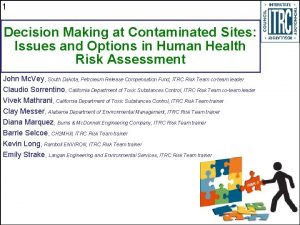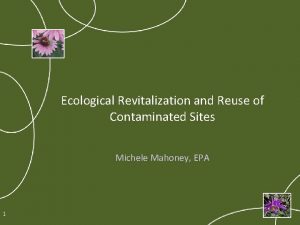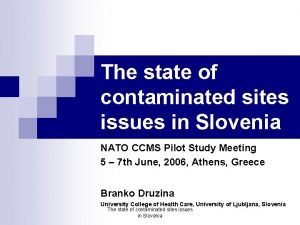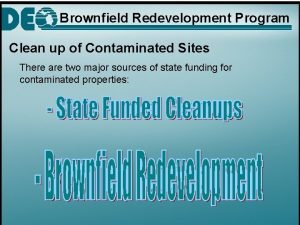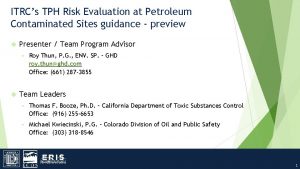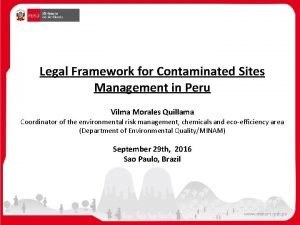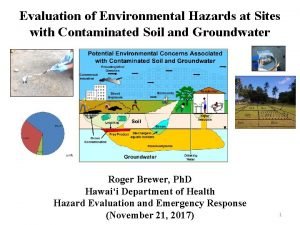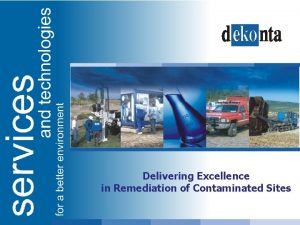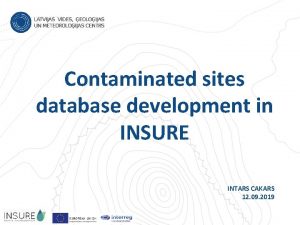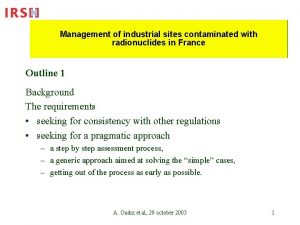The history and evolution of contaminated sites regulation




















- Slides: 20

The history and evolution of contaminated sites regulation and remediation in the Netherlands A historic overview Solution Provider bij bodemsanering Solution Provider in environmental asset management Leading in soil and groundwater remediation

PREHISTORIC AGE: < 1978 • First environmental legislation: Nuisance act of 1875: Art. 1. Het is verboden inrigtingen, welke gevaar, schade of hinder kunnen veroorzaken, op te rigten zonder vergunning, welke, behoudens de bij deze wet gemaakte uitzonderingen, door het gemeentebestuur wordt gegeven • 1928: Natural Beauty Act (enacted to prevent Lake Naarden, a man-made lake – turned into nature – from being landfilled with Amsterdam City waste) • • • 1967: Nature Protection Act 1970: Act Protection Surface Waters Prior to 1972: concept soil pollution unknown Underground used for waste disposal 1972: legislation on soil first announced in Queen’s Speech (equivalent to US ‘State of the Union’) Note: ‘Soil’ refers to (subsurfaces) solid-phase soil, groundwater, gasses and biology) Solution Provider in environmental asset management

PROTOHISTORIC AGE: 1979 - 1982 • 1979: Lekkerkerk Development on landfill site. Officially only construction & demolition waste, chemical waste dumped illegally. First signs: strange taste in potable water. Signs ignored. 1978 gas main burst Assessment dissolved in solvents: repair worker overcome by toxic fumes: panic ! started 1979, remediation 1980. • First public appearance of HM Queen Beatrix after her coronation Minister Ginjaar: Pledge to Clean The Nation. Lekkerkerk costs: NLG 160 M; Estimate early ‘ 80: maximum 4200 ‘suspect’ & 350 remediation cases, costs € 450 M • Budget no issue, but politicians question: ‘how clean is clean’? Scientific research: dunes and nature area used as reference for the ‘famous’ Dutch List (A, B & C levels for solid soil & groundwater). • Result: almost the entire nation is polluted. Cost sky-rocket to NLG 50 E+09. Solution Provider in environmental asset management

EARLY HISTORY 1982 - 1987 • 1982: Interim-act Soil Remediation Effective 1 -1 -1983 Contains regulations on soil & groundwater remediation, introduces fixed norms (ABClevels: A= natural background level ; C= threshold level mandatory remediation; B= average A&C, trigger more detailed assessment) • Principle: the Government implements remedation. The government remediates to restore the A - level and recovers costs from polluter. Ownership is not relevant, but there are clauses to counter speculation. • Recovering legal action failed Cases went to Supreme Court: ruled that contamination caused before 1975 could not be recovered. (cf. Shell, Fasson). • Consequence: Costs landed with the government. Remediation program stalled. Solution Provider in environmental asset management

MIDDLE AGES 1987 - 1994 • 1987: Soil Protection Act (Interim-act Soil Remediation remained in force) Contains regulations to prevent soil & groundwater contamination. Differentiates between New (On or after 1 -1 -1987): full clean-up mandatory (irrespective of risk) Historic (Before 1 -1 -1987): risk-driven remediation (Multi-functional unless too expensive: then Isolating, Containing, Monitoring (ICM)) • Early ’ 90: “gedoogbeleid”: Tolerating Policy Multifunctional was far too expensive: many ICM remediation projects (even if multi-functional should have been selected), Often, only top soil addressed (in violation of the law, but officially tolerated and accepted) • Inventory Soil & Groundwater contamination Start nation-wide soil quality mapping, all business required to assess & report soil quality approx. 600. 000 cases found; NLG 200 E+09 • Remediation only as last resort, in particular private business delayed Soil remediation came to a halt (or never started: government refuses to pay, businesses could /would not). Solution Provider in environmental asset management

REVOLUTION 1994 - 1995 • 2005: 2 e Phase Soil Protection Act; incorporating Interim-act Soil Remediation ABC levels replaced by S (desired level) and I (Intervention level). B-level eliminated officially, but the market reintroduced it as ‘T’- (intermediate) level. Levels based on new research, and to some extent dependent on soil type & risks. • Still: law demands Multi-functional, in real world: tolerating policies remain Multifunctional far too expensive, many remediation projects based on C-soil –risk approach and still many cases of top soil only remediation (against the law, but still tolerated officially) • Shift in accountability Now mostly the polluter held liable. If not found, then the site owner. government last to be accountable Solution Provider in environmental asset management

RENAISSANCE 1995 - 2006 • 1995 - 2001: BEVER Beleidsvernieuwing Bodemsanering. New policy on soil & groundwater remediation: studies into better policy and legislation to incorporate real-life practice: If it cannot be done the way it should, it should be done the way it can! • New policy One of the studies results in a new policy: functional remediation final report issued on 2 nd July 2001 • From Multi-functional to Functional Still not incorporated into law, but well based en generally accepted policy • Stable Final Situation (facilitates re-use of non-leaching slightly contaminated material) a. No further migration of contamination (stable situation); b. No risk (human exposure or ecological); c. No sensitive receptors at risk; d. No disturbance of stable situation from anticipated developments Solution Provider in environmental asset management

Choice of options Step 1 Stable final situation To be reached in 30 years maximum Step 2 Step 3 No contramination Step 4 No Stable final situation Step 5 Large residual contamination Small residual contamination Residual contamination Risks and constraints None No risk, no restraints, no migration through active containment and/or isolation None Migration Stability demonstrated within Monitoring system & fall-back 30 years, including monitoring scenario required Care after reaching remediation goals None Passive Active Registration Monitoring More source & plume removal Reduction in care Isolation, containment & monitoring Solution Provider for soil & groundwater remediation

Phase 3 2006 - 2020 • 2006: Review Soil Protection Act Remediation goal Stable final situation, to be reached everywhere in 2030 (for historic contamination only; for new contamination 100% removal mandatory). • Remediation Order Owners (NB NOT polluters or government) have duty to remediate. Mainly carried out by investing industry and property developers. Orphin cases land with government (larger municipalities or provinces; very large cases (>€ 10 M) with national government. • Risk-based Remediation goal Based on Sanscrit model, but other forms of proof now accepted. • Subsidy for Industry Government subsidises part of remedial costs: - Max 70% if owner is not the polluter, AND site was acquired before 1975 - If site acquired between 1975 and 1987: less subsidy - If site acquired between 1987 en 1995: limited subsidy - If site acquired after 1995: no subsidy Solution Provider in environmental asset management

The Reverend vs The Merchant Costs of remediation in E+09 Euro Remedial Costs vs Residual Levels 250 Motto: By changing the Policy, the Dutch government cut remedial costs by 150 billion Euro 200 150 100 (225, 000, 000 $CAD). 50 0 Policy 1986 0 2 4 6 8 10 12 14 Accepted Residual Concentration (relative) 16 Policy 2006 Solution Provider for soil & groundwater remediation

FUTURE 2009 – 2020 European Water Directive European law is binding for European Union Members • Water Directive Sets norms for surface water. However: surface water is fed by groundwater. , therefore the Water directive affects groundwater quality too. • Groundwater daughter-directive Will set very strict norms for groundwater quality. Groundwater quality is strongly related to soil quality: therefore new & strict norms for soil quality. Will this be ‘reverend & merchant’ debate all over again? Solution Provider in environmental asset management

Potable Water • 60% potable water from groundwater Protection of groundwater as source for potable water was always inplicitly included; Groundwater daughter-directive makes this explicit. • Production aquifers are protected 25 year protection zone Solution Provider in environmental asset management

Phase 4: 2021 - ? ? ? Complete overhaul of legislation associated with use of physical space (spatial planning & zoning, permitting, environmental etc. ) It replaces 26 exisiting laws & regulations. It aims to: • Better coordinate planning for spacial planning & zoning, environment &; • Promote sustainable development (eg wind energy); • More flexibility for municipalities, provinces and water boards to beter match their plans for use of physical space to their needs and goals Solution Provider in environmental asset management

Phase 4: 2021 - ? ? ? Impact of new legislation • Governments: National, Provincial & municipal govenments must produce an integrated vision on use of physical space, taking all interests into account (instead of focussing on individual projects • 1 stop shop for people & businesses Only one digital permit application required to start new projects or activities. The relevant government will then decide. If 2 or more levels of government are involved, one will decide. • Less assessments required for businesses Permit application procedures will require less assessment data & existing data expires later. This reduces costs. Solution Provider in environmental asset management

Phase 4: 2021 - ? ? ? Impact of new legislation on soil & groundwater remediation • Exisiting contamination: Contamination (per sé) no longer triggers need for remediation • Remediation required when: • – Contamination actually constitutes a risk (exposure, migration) – Contaminated volume of soil / groundwater actually expands more than allowed – Site use changes and new useage requires more stringent soil/groundwater quality New contamination Remains unaccepted and ‘must be undone’ – – Start ASAP ‘Risking away’ is not an option; Regulatory remediation goals do not apply BUT. . . Measures must be ‘reasonable’ and once started, no criteria for time frame. Solution Provider in environmental asset management

Phase 4: 2021 - ? ? ? Liability • After remediation (case completed with regulatory approval): – No further action required (government guaranteed) Unless new information proves that older information was incomplete of incorrect – When site use changes, initiator of change is responsible to pay for additional measures (if any) Solution Provider in environmental asset management

Phase 4: 2021 - ? ? ? Liability • With residual contamination – Not stable: containment measures & monitoring – Stable: monitoring to prove stability, then no action • Liability remains with responsible party (public and private / civil): – Owner of property is (usually) liable – Can be ‘sold’ – Two organizations in NL specifically to take-on liability: • Government-owned ‘Incorporated’ • (not-for-profit) foundation, govenment guaranteed Solution Provider in environmental asset management

Remedial Approach • Excavation is primary choice (in particular for small cases) • Landfilling is not allowed at all, except in cases of untreatable soil Hot issue now with PFAS, Chem. X and related highly stable and recalcitrant compounds. Standard treatment does not work, so excavated soil now goes into stockpiling waiting for cost-effective treatment to be developped. • In situ is primary choice in large cases and in urban (densely built-up) area’s • Often combined: excavation of hot zones and/or for construction, rest by in situ during redevelopment. Solution Provider in environmental asset management

Accountable Party 1982 1995 2006 2021 First Accountable Party Government Polluter Owner Initiator of change Will attempt to recover costs from Polluter Owner Polluter Increase in value; Discount purchase price Last party to be held accountable (Owner) Government NB: Applies only to existing contamination. For new contamination polluter pays Solution Provider for soil & groundwater remediation

Thank you for your attention Groundwater Solution Provider in environmental asset management Leading in soil and groundwater remediation Technology Sheffieldstraat 13 3047 AN Rotterdam Solution Provider P. O. Box 12115 3004 CG Rotterdam Nederland bij bodemsanering Leading in soil and groundwater remediation E-mail: Web: Tel: info@gtbv. nl www. gtbv. nl info@gtbelgium. be www. gtbelgium. be +31 (0)10 238 2850 Cell: +31 65 391 6526
 Contaminated wound
Contaminated wound Chaernobyl
Chaernobyl Australian contaminated land consultants association
Australian contaminated land consultants association Waste mangment
Waste mangment Contaminated product insurance
Contaminated product insurance First repertory was published by
First repertory was published by Facility management history and evolution
Facility management history and evolution During medieval time, garde manger refers to
During medieval time, garde manger refers to Sankaran's card repertory
Sankaran's card repertory History and evolution of repertory
History and evolution of repertory History and evolution of health information technology
History and evolution of health information technology Chapter 14 evolution a history and a process
Chapter 14 evolution a history and a process Evolution of total quality management
Evolution of total quality management When administering ear drops to adults the pinna is pulled
When administering ear drops to adults the pinna is pulled Im injection sites and volumes pediatrics
Im injection sites and volumes pediatrics Brownfield advantages and disadvantages
Brownfield advantages and disadvantages It focuses on short updates of the user
It focuses on short updates of the user Epaxial im injection dog
Epaxial im injection dog Tivoli model two
Tivoli model two Dorsogluteal vs ventrogluteal injection sites
Dorsogluteal vs ventrogluteal injection sites Advantages and disadvantages of brownfield sites
Advantages and disadvantages of brownfield sites
